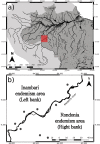Most species are not limited by an Amazonian river postulated to be a border between endemism areas
- PMID: 29396491
- PMCID: PMC5797105
- DOI: 10.1038/s41598-018-20596-7
Most species are not limited by an Amazonian river postulated to be a border between endemism areas
Abstract
At broad scales in the Amazon, it is often hypothesized that species distributions are limited by geographical barriers, such as large rivers (river-barrier hypothesis). This hypothesis has been used to explain the spatial-distribution limits of species and to indicate endemism areas for several phylogenetic lineages. We tested the ability of the river-barrier hypothesis to explain patterns of species diversity and spatial-distribution limits for 1952 easily-detected species in 14 taxonomic groups that occur around the Madeira River, and our results indicate that the hypothesis that the Madeira River is the border between endemism areas and explains much of the diversity found in the region is inappropriate for >99% of species. This indicates that alternative hypotheses should be proposed to explain the limits of distributions of species around the Madeira River, as well as a revision of the criteria that are used to determine species-endemism areas.
Conflict of interest statement
The authors declare that they have no competing interests.
Figures




References
-
- Tuomisto H, Poulsen AD. Pteridophyte diversity and species composition in four Amazonian rain forests. J. Veg. Sci. 2000;11:383–396. doi: 10.2307/3236631. - DOI
-
- Emilio T, et al. Soil physical conditions limit palm and tree basal area in Amazonian forests. Plant Ecol. Divers. 2014;7:215–229. doi: 10.1080/17550874.2013.772257. - DOI
-
- Schietti J, et al. Vertical distance from drainage drives floristic composition changes in an Amazonian rainforest. Plant Ecol. Divers. 2013;7:1–13.
-
- Zuquim G, et al. Predicting environmental gradients with fern species composition in Brazilian Amazonia. J. Veg. Sci. 2014;25:1195–1207. doi: 10.1111/jvs.12174. - DOI
-
- Garda AA, et al. Microhabitat Variation Explains Local-scale Distribution of Terrestrial Amazonian Lizards in Rondônia, Western Brazil. Biotropica. 2013;45:245–252. doi: 10.1111/j.1744-7429.2012.00906.x. - DOI
Publication types
MeSH terms
LinkOut - more resources
Full Text Sources
Other Literature Sources

